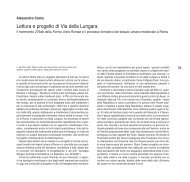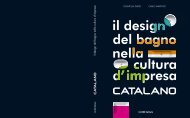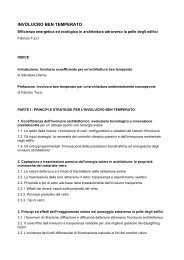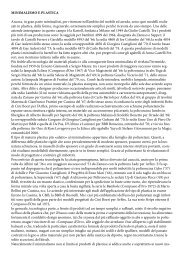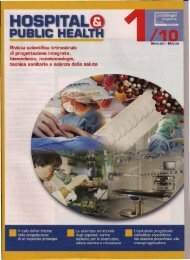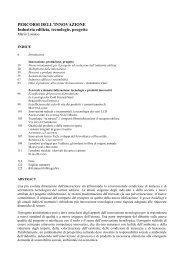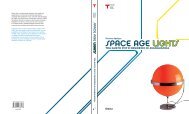Mostra/Apri - Facoltà di Architettura - Sapienza
Mostra/Apri - Facoltà di Architettura - Sapienza
Mostra/Apri - Facoltà di Architettura - Sapienza
You also want an ePaper? Increase the reach of your titles
YUMPU automatically turns print PDFs into web optimized ePapers that Google loves.
4.<br />
36<br />
CLOSE UP | innovation&research<br />
anche la cialda e il contenitore del latte: ovvio, per macchiare<br />
l’immaginario caffè. Per essere al passo con i tempi ha anche<br />
l’orologio a led incorporato con i tipici numeri a segmenti, ma è<br />
<strong>di</strong>segnato, per sempre immobile sulle 8.00.<br />
Oggi, come accennato, le normative relative ai giochi per i bambini<br />
impongono livelli <strong>di</strong> sicurezza molto alti, <strong>di</strong> conseguenza nel<br />
panorama dei mini-elettrodomestici la funzione cottura essendo la<br />
più rischiosa è, salvo rare eccezioni, simulata, talvolta con grande<br />
verosimiglianza. Ma non è sempre stato così.<br />
Agli inizi degli anni ‘70 la Harbert sas – dal nome straniero, ma in<br />
realtà <strong>di</strong> Milano – produsse “Dolce forno”. Appena apparve la sua<br />
réclame su Topolino questo giocattolo dal colorato aspetto lu<strong>di</strong>co<br />
ma funzionante veramente, occupò stabilmente la prima posizione<br />
nelle letterine <strong>di</strong> Natale della maggior parte delle bambine.<br />
Era, infatti, una vera innovazione nel mondo dei giocattoli: grazie al<br />
calore <strong>di</strong> due lampa<strong>di</strong>ne a incandescenza da 100 watt, poi sostituite<br />
con quelle da 60 watt, cuoceva i piccoli dolci che si potevano<br />
realizzare secondo il mini ricettario allegato, utilizzando ciotoline,<br />
formine, misurino e mattarello, sempre in dotazione. Le lampa<strong>di</strong>ne<br />
erano sostituibili grazie all’utilizzo dell’apposita chiave a brugola,<br />
rigorosamente “da consegnare ai genitori”. Questa azienda fu per<br />
un ventennio la fucina dei desideri dei bambini 2 , tra i tanti giocattoli<br />
produsse: “Dolce gelato” che, azionato a manovella, raffreddava<br />
creme a base <strong>di</strong> latte e frutta grazie a un cilindro metallico riempito<br />
<strong>di</strong> ghiaccio e sale; “Dolce pastamatic” completa <strong>di</strong> varie trafile<br />
per estrudere la pasta secondo varie forme; “Dolce bon bon” per<br />
preparare caramelle e gelatine; “Dolce zucchero filato”... Insomma,<br />
rispondeva a tutti i bisogni dei piccoli chef e ne induceva <strong>di</strong> sempre<br />
nuovi. Dal canto suo Giochi Preziosi, che nel 1994 acquisì l’azienda Harbert, rispose con una<br />
<strong>di</strong>versa filosofia, quella della simulazione: lanciò sul mercato “Friggi friggi”, una bistecchiera che<br />
non cuoceva veramente, ma sulla quale simil-bistecche e simil-hamburger si scurivano, come<br />
magicamente rosolate, nel giro <strong>di</strong> qualche minuto. Strofinandole poi tra le mani tornavano<br />
al colore rosa precottura, infatti il materiale con il quale erano realizzate le finte pietanze a<br />
contatto con il calore riacquistava l’aspetto originario. Si tratta <strong>di</strong> uno dei primi esempi dell’uso<br />
<strong>di</strong> materiale termocromatico nei giochi dei bambini, foriero, come abbiamo visto, <strong>di</strong> un grande<br />
futuro <strong>di</strong> simulazioni.<br />
(2) La Harbert sas era una delle maggiori aziende italiane <strong>di</strong> giocattoli.<br />
Ha inventato nuove tipologie <strong>di</strong> giochi che in molti casi hanno<br />
fatto scuola, come il “Festacolor” che proiettava sette <strong>di</strong>apositive<br />
unite in un’unica striscia <strong>di</strong> cartone, prevalentemente con storie<br />
della Walt Disney, da far scorrere manualmente. Applicò al mondo<br />
dei giocattoli nuove tecnologie - come nel caso del gioco da tavolo<br />
nel quale un piccolo autobus tramite un sensore riusciva a percorrere<br />
una strada - e sfruttò con maestria le prestazioni dei materiali<br />
come nel caso delle membrane elastiche riempite <strong>di</strong> una specie <strong>di</strong><br />
gel per la realizzazione <strong>di</strong> “Mister Muscolo”, il pupazzo che poteva<br />
essere allungato a piacere e riprendeva le <strong>di</strong>mensioni originarie.<br />
4.5. Rosalie, Small Foot Company 1522. Cucinotto in legno con<br />
sportelli apribili, manopole girevoli, in dotazione cibi e stoviglie.<br />
Rosalie cooker, Small Foot Company 1522. Wooden cooker<br />
with doors that open, rotating handle, food and pans supplied.<br />
ENGLISH TEXT<br />
Latest generation toys have created a miniature home environment, especially as regards the<br />
kitchen, using high performance materials, technical devices or simple effects to reproduce<br />
incre<strong>di</strong>bly lifelike functions of home appliances: water appears to boil in mini-pans on glass-<br />
ceramic hobs that seem lit, ergonomic vacuum cleaners complete with rotating brushes offer<br />
powerful suction, irons have a steam effect, washing machines with rotating drums produce the<br />
5.<br />
sounds of a wash and imitate the control panel with backlit <strong>di</strong>splays, while mini solar panels light<br />
up LEDs to illuminate the kitchen... all in small-size.<br />
In this Lilliputian world of plastic, chrome, elastic membranes and thermochromatic materials<br />
there are still solid wood toys – little household appliances made completely of wood, where a<br />
child’s imagination makes up for the lack of high performance functions.<br />
The adultisation of childhood and children imitating adult actions have been essential elements<br />
of play since ancient times. In many cases miniaturising objects for play has been accompanied<br />
by a more or less lifelike simulation of their function.<br />
If you were a child in the 1960s one of the greatest marvels – one that everyone could afford<br />
– was a little plastic bottle you used to give your dolls milk. When you tilted it the white liquid<br />
<strong>di</strong>sappeared. Now this simple yet magical effect makes us smile when we compare it to the<br />
devices of toys today, especially those that are miniature versions of home appliances. The<br />
imitation of reality and simulation of phenomena is increasingly realistic and uses advanced<br />
materials, high-tech performance or mere lifelike details.<br />
The height of sophistication are the scaled-down versions of electrical appliances and fully<br />
equipped kitchens – aimed at bud<strong>di</strong>ng baby housewives but also appealing to boys – that<br />
reproduce the functions of the models that inspired them or simulate them safely (in full<br />
compliance with the stringent regulations that govern toys).<br />
In these miniature kitchens the tap really produces water, the motorised hood doesn’t extract air<br />
but reproduces the annoying noise perfectly, the fridge doesn’t cool anything, but a rotating fan<br />
ensures that air circulates inside and mini-beaters with an ultra-modern blender mix tiny portions<br />
of flour. What next? Water boils in a mini-pan - it doesn’t really, but when you lift the mini-lid<br />
with mini-oven gloves (useless, but soon there’ll be a pan that produces imaginary heat) it’s hard<br />
to see that the bubbles rising and falling aren’t the result of water reaching 100 C°, but the<br />
skilful use of a semi-transparent plastic membrane, moved by invisible battery operated minisprings,<br />
which also produces the noise of boiling.<br />
The simulation of the hob burning is also incre<strong>di</strong>bly realistic – nothing like the little flickering<br />
fire in the nativity scene! Thanks to a dual effect of light and sound ‘pans on the stove hiss like<br />
real ones’ (in the words of the advert for one of these toy kitchens). Of course there are also<br />
the backlit oven tops that imitate those in glass-ceramic; nothing is forgotten in the imitation of<br />
technological development.<br />
This domestic wonderland is also inspired by educational motives: the <strong>di</strong>fferent compartments of<br />
the bins help children separate rubbish, and the Eco programmes of the mini-washing machines<br />
teach them not to waste water, the little <strong>di</strong>rectional solar panels on the dolls houses turn on LED<br />
lights in various rooms, demonstrating efficient alternative energy to our future citizens. They will<br />
probably be <strong>di</strong>ehard consumers, but at least, we hope, environmentally aware.<br />
All the sense are stimulated. Not only sight, hearing and touch, but smell also comes into play -<br />
just like in the most recent trends in contemporary design. Food in the mini-cupboards, created<br />
perfectly to scale, emits the scents of vanilla, strawberry, chocolate, wood smoke and even the<br />
fragrance of panettone and pandoro, so there’s something for everyone. In fact, artificial aromas<br />
that resist over time, even after repeated washing, can be easily added to the synthetic pastes<br />
with which these little meals are made, as they are incorporated into the material before it is<br />
moulded. And so the miniaturising goes on. There is a battery operated Kobold vacuum cleaner



